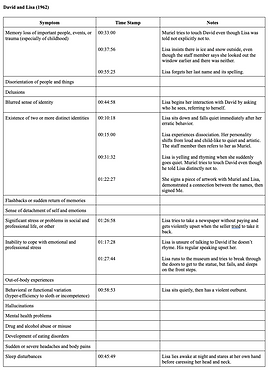
Academic Conversation and Inquiry Process
A summary of the gap in the academic conversation and the ways in which my research will contribute to the community, in addition to an overview of my research process and choices.
Gap in the Academic Conversation
There has been extensive research on Dissociative Identity Disorder dating back hundreds of years, and encompassing information on the causes, symptoms, and treatments. It would be assumed that, with such thorough findings, the portrayals of DID would be a strong representation of what the disorder actually is. That is not the case.
Previous academic studies have found that the portrayals of DID in individual films fall short of reality or depict the disorder in an extreme negative light. As important as these works are at opening up the conversation of mental disorders, they have a smaller scope by only focusing on single films. My study aims to expand the conversation by creating a comparison of several works while not only focusing on psychology, but also history.
The ultimate goal of my research is to determine a progression of symptomatic portrayals in relation to clinical knowledge. I hope to present research that separates psychology and fiction to reduce the stigmatization of mental disorders naturally formed by audience perceptions of media.
Research Process, Progress, and Choices

Pictured above is my work during the film analysis stage of my trials. To my left is the master symptom list I created as a reference and on the computer screen is a table for qualifying portrayals.

In order to achieve the aforementioned goal, I will be completing two major steps in my research: film analysis and qualitative research on case studies. If in search of more information, my methodology is briefly discussed in this overview video and my Road to Research blog post.
As of now, the end of February 2023, I am in the process of finalizing my research. I have completed the film analysis component, and am in the transitioning stage to research on case studies. Overall, the film analysis was smooth sailing. The symptoms portrayed were generally recognizable and I had no trouble getting access to the films. That being said, it was difficult to dedicate enough consecutive time to watch a film, since each one took between two and hour hours to analyze. Otherwise, the only issue I ran into was with The Mummy (2017). While it was labeled as portraying Multiple Personality Disorder per the guidelines of my selection, it did not. The character who supposedly had the disorder was possessed and woke up after being buried for five thousand years. In consideration of this, I discarded the film as an outlier and chose an alternative, Split (2016)..
With the data collected from film analysis, I am creating a spread sheet to quantify the symptomatic portrayals. Though the spread sheet is not yet completed, it will be finalized with the rest of my findings. Over the course of the next week I will read through case studies to collect data on historic knowledge. I will make final comparisons to the film analysis data before completing the research stage of my project.
Completed film analysis table for David and Lisa (1962). Columns from left to right are the symptoms, time stamps, and notes regarding each symptom portrayal.
Below is the incomplete spreadsheet I created to display the data from the film analysis stage of my research. Symptoms from the tables (pictured to the upper left) are quantified and inputted here.
